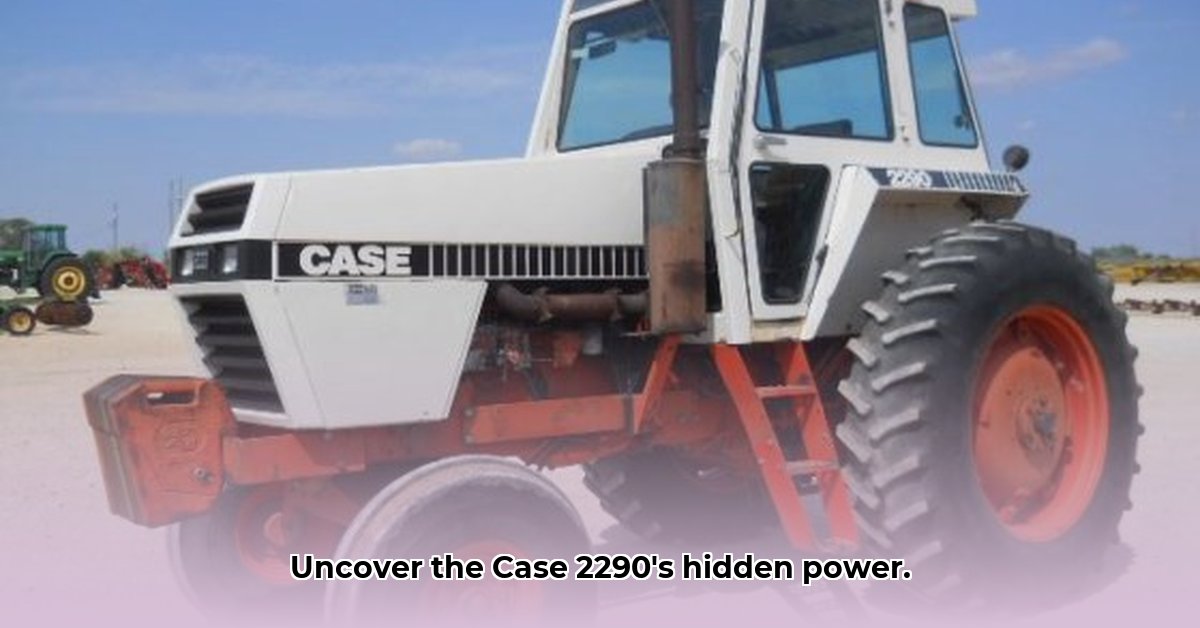
The J.I. Case 2290: a name that evokes images of powerful, dependable farm machinery from the late 1970s and early 1980s. This comprehensive guide delves into the specifications, history, and restoration of this iconic tractor, appealing to collectors, historians, and anyone interested in vintage agricultural technology. Whether you're assessing its market value or planning a meticulous restoration project, this article is your essential resource. For even more in-depth information, check out this dedicated website: Case 2290 Details.
A Look Back: Historical Context of the Case 2290
The late 1970s and early 1980s saw a significant shift in agricultural practices. Farmers needed more powerful and efficient machinery to handle increasingly larger fields and improve productivity. The Case 2290 directly addresses this need. It represented a technological leap, combining robust power with enhanced operator comfort—a significant departure from the simpler tractors of previous decades. This model wasn't merely about brute strength; it also emphasized the operator's well-being, reflecting a changing perspective in agricultural equipment design. Images from the era depict the 2290 working across diverse terrains, a testament to its versatility and reliability. This tractor is more than just machinery; it's a snapshot of an era.
Detailed Specifications: A Technical Overview
Various online databases provide specifications for the Case 2290. However, minor discrepancies exist due to different testing methodologies and reporting practices. This section aims to present a consolidated overview, noting inconsistencies where they occur. Remember, your specific tractor might show variations due to modifications or wear.
| Specification | Value (Source A / Source B) | Notes |
|---|---|---|
| Engine | 8.3L, 6-cylinder diesel | A powerful and robust diesel engine, known for its reliability. |
| PTO Horsepower | 129 hp (approx.) | Power Take-Off (PTO) horsepower; exact figures vary based on testing protocols. |
| Drawbar Horsepower | 109.21 hp (Source A) | Drawbar horsepower, indicating pulling capacity; may vary across data sources. |
| Fuel Tank Capacity | 246 L | Capacity in liters; essential for long work days in the field. |
| Transmission | Full-Power-Shift (Example) | The specific transmission type impacts operational performance and capabilities. |
| Hydraulics | (Lift Capacity, Flow Rate) | Hydraulic system specs, crucial for understanding implement operation. |
| Weight | 18,000 lbs (approx.) | Approximate weight; can vary based on configuration (2WD vs. 4WD). |
| Dimensions | (Length, Width, Height) | Overall dimensions are vital for storage and maneuvering considerations. |
| Steering | Hydrostatic power steering | A significant advancement, offering substantial improvements in maneuverability. |
(Note: Replace bracketed placeholders with data from reliable sources like TractorData or Tractor-Specs.)
Operational Characteristics and Features
The Case 2290 was built for demanding agricultural tasks. Its substantial horsepower made it ideal for large-scale farming operations. While powerful, its fuel efficiency likely paled in comparison to modern tractors. However, its hydrostatic power steering was a notable feature for its time, providing superior maneuverability and reduced operator fatigue. The "Silent Guardian" cab (if equipped) offered a quieter working environment—though the actual noise reduction level remains to be fully verified. Comparing the 2290 with its contemporary counterparts helps to understand its strengths and weaknesses within the technological landscape of the time. How did its fuel economy stack up against competitors? What applications did it excel at, and were there any noticeable shortcomings?
Restoration and Maintenance: A Practical Guide
Maintaining a classic tractor like the Case 2290 is a commitment, but a rewarding one. This section provides actionable steps to ensure your tractor remains operational and a valuable piece of agricultural history.
1. Parts Sourcing: Finding replacement parts requires dedicated effort. Online forums dedicated to vintage tractors are indispensable resources, connecting owners with specialized suppliers and fellow enthusiasts.
2. Regular Maintenance: Proactive maintenance is essential. Regular lubrication, consistent inspections, and timely repairs prevent larger, more costly issues. A well-maintained 2290 will last significantly longer, offering years of reliable operation.
3. Common Problems: Age inevitably brings wear and tear. Common issues include seals, hoses, and electrical components. Researching and understanding common problems for the Case 2290 allows proactive preparation.
4. Record Keeping: Maintain comprehensive repair and maintenance records (including detailed notes and photographs). This documentation proves invaluable for future troubleshooting.
Collector's Value and Market Analysis
For collectors, the Case 2290 holds significant value, representing a piece of agricultural history. Its robust construction, powerful engine, and place in the evolution of farm machinery make it a sought-after item. However, the market value varies greatly based on condition, originality, and completeness of documentation. Consulting with specialists in vintage machinery or browsing online marketplaces can help determine a tractor's current market price. Are there particular features collectors prize more highly?
Conclusion: A Legacy of Power and Precision
The Case 2290 stands as a testament to engineering prowess and its impact on agricultural mechanization. This guide provides a comprehensive overview, but further research is encouraged. Owning and maintaining this vintage tractor is both challenging and fulfilling, providing a powerful link to farming's past and a chance to preserve a significant piece of our heritage. The 2290's legacy extends beyond its operational capabilities; it also reflects the changing relationship between technology and the agricultural landscape.